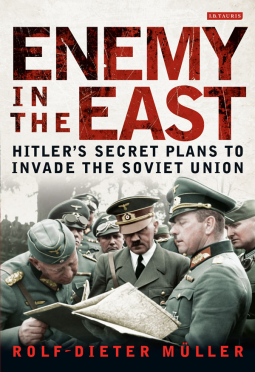
Enemy in the East
by Rolf-Dieter Müller
This title was previously available on NetGalley and is now archived.
Send NetGalley books directly to your Kindle or Kindle app
1
To read on a Kindle or Kindle app, please add kindle@netgalley.com as an approved email address to receive files in your Amazon account. Click here for step-by-step instructions.
2
Also find your Kindle email address within your Amazon account, and enter it here.
Pub Date 3 Feb 2015 | Archive Date 11 May 2015
I.B.Tauris | I. B. Tauris
Description
The unknown story of Hitler's plan to invade the Soviet Union
Operation Barbarossa, Hitler’s invasion of the Soviet Union in 1941, led to one of the most brutal campaigns of World War II: of the estimated 70 million people who died in the war, over 30 million died on the Eastern Front. Although it has previously been argued that the campaign was a pre-emptive strike, in fact, Hitler had been planning a war of intervention against the USSR ever since he came to power in 1933. Using previously unseen sources, acclaimed military historian Rolf-Dieter Müller shows that Hitler and the Wehrmacht had begun to negotiate with Poland and had even considered an alliance with Japan soon after taking power. Despite the signing of the Molotov-Ribbentrop Pact, at the declaration of war in September 1939, military engagement with the Red Army was still a very real and imminent possibility.
In Enemy in the East, Müller takes us behind the scenes of the Wehrmacht High Command, providing a fascinating insight into a lesser known story of World War II.
Praise for Rolf-Dieter Muller's The Unknown Eastern Front
'The Unknown Eastern Front demonstrates that history – especially of a highly sensitive issue like this one – is rarely about neat binary categories of black and white, good and evil.'
Roger Moorhouse, TLS
'In lifting the veil with which history has shrouded these men, Müller... has opened up a new vista on a largely forgotten, and sometimes deliberately neglected, but crucial aspect of recent history.'
Nigel Jones, Spectator
'...this is an important subject... [Müller] supplies full and useful detail on the contribution of all the different peoples who participated, with information on the numbers of soldiers and the tasks they were expected to fulfill.'
Richard Overy, History Today
'A definitive work.'
Die Welt
Available Editions
| EDITION | Hardcover |
| ISBN | 9781780768298 |
| PRICE | US$29.00 (USD) |
Links
Average rating from 15 members
Readers who liked this book also liked:
Natalie Horseman
Children's Fiction, Outdoors & Nature, Parenting, Families, Relationships
Lieve Snellings
Children's Nonfiction
Lieve Snellings
Children's Nonfiction, Outdoors & Nature















